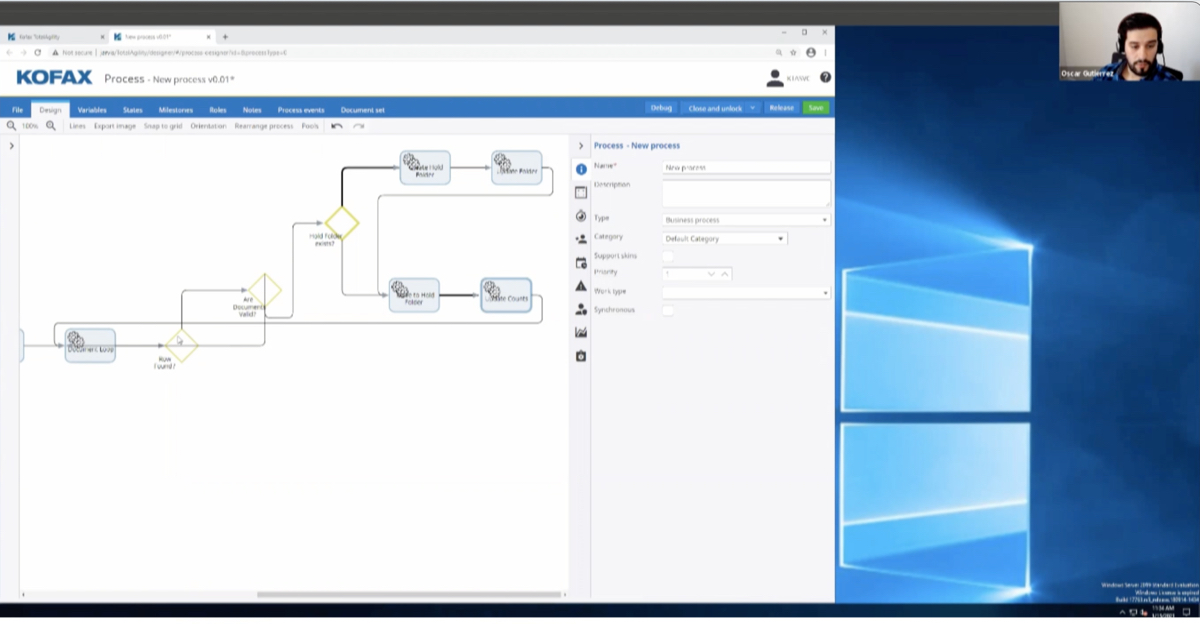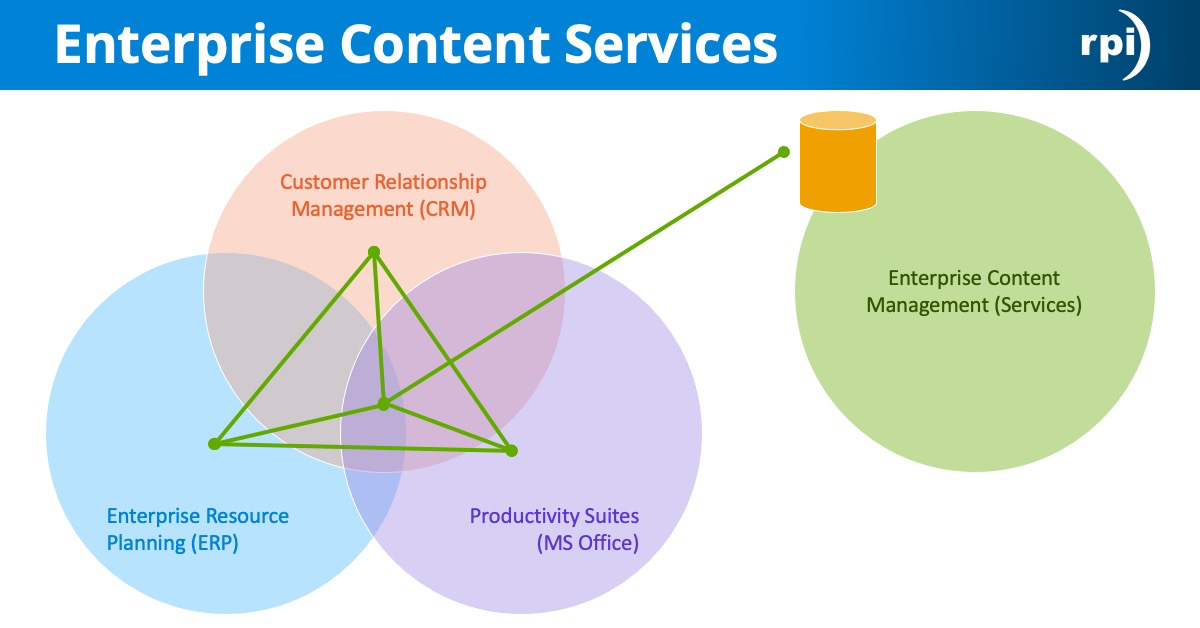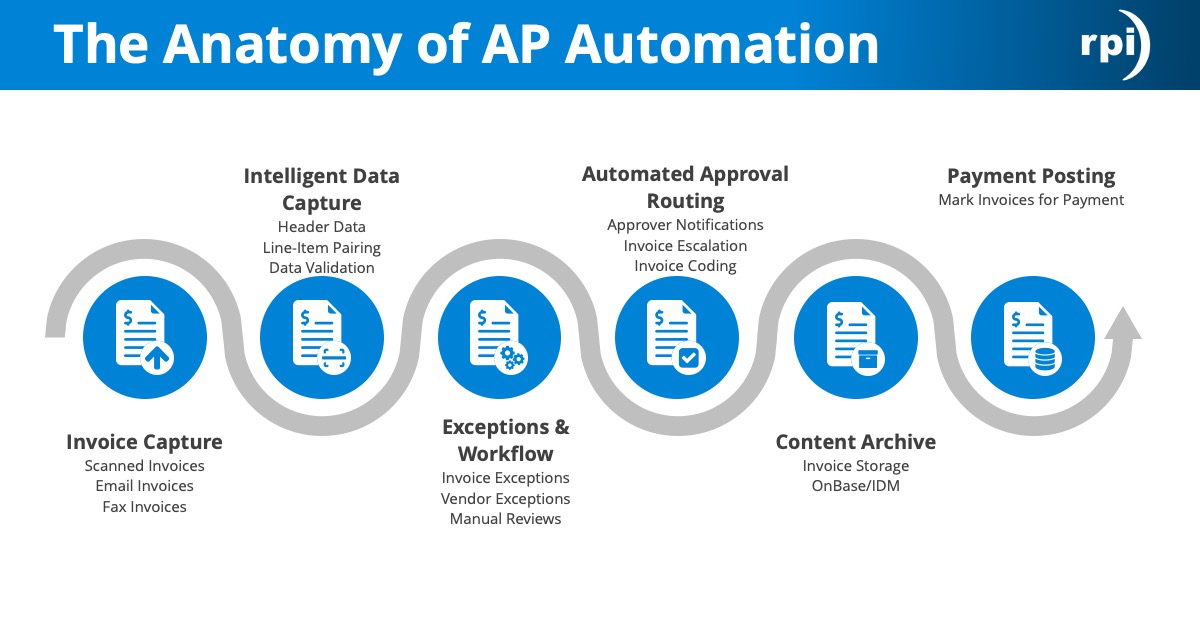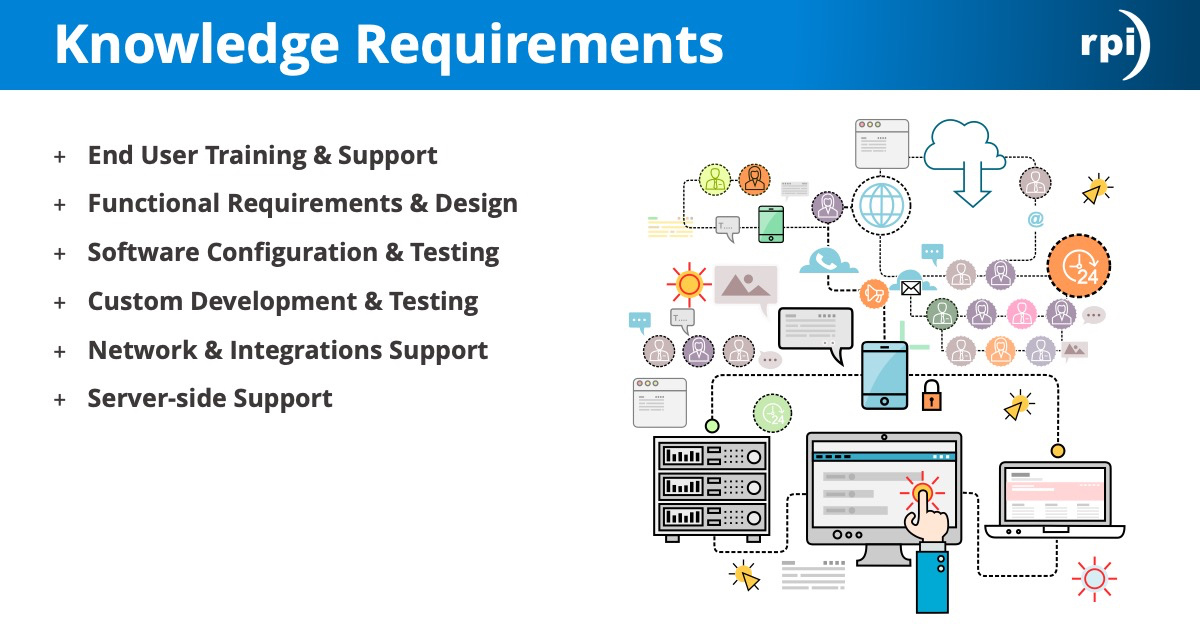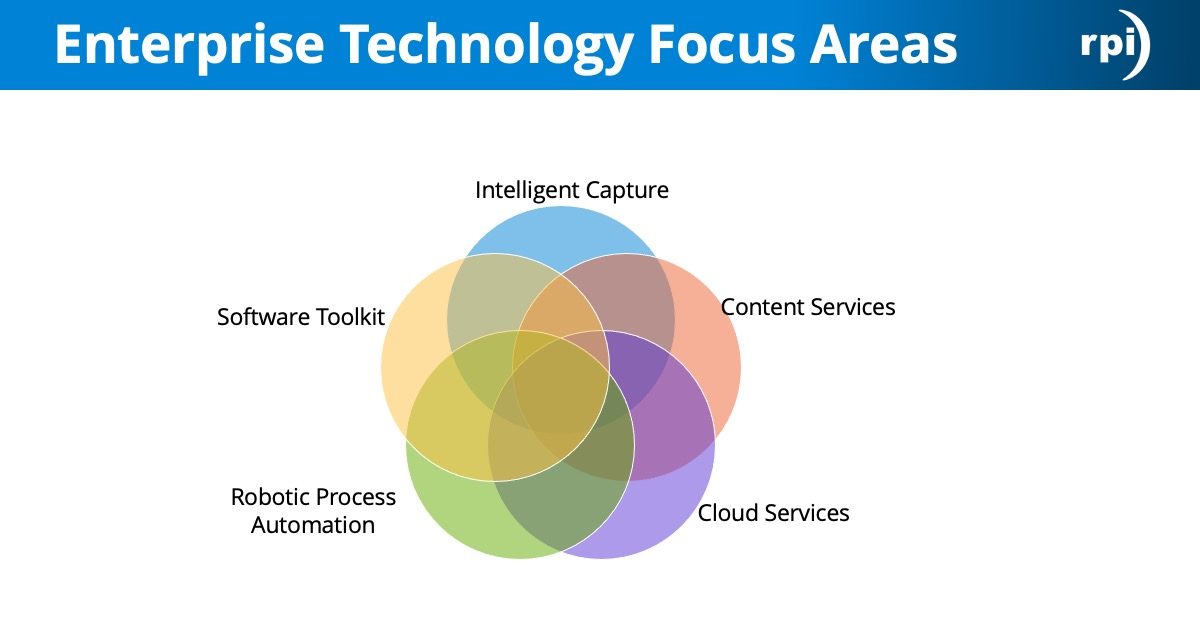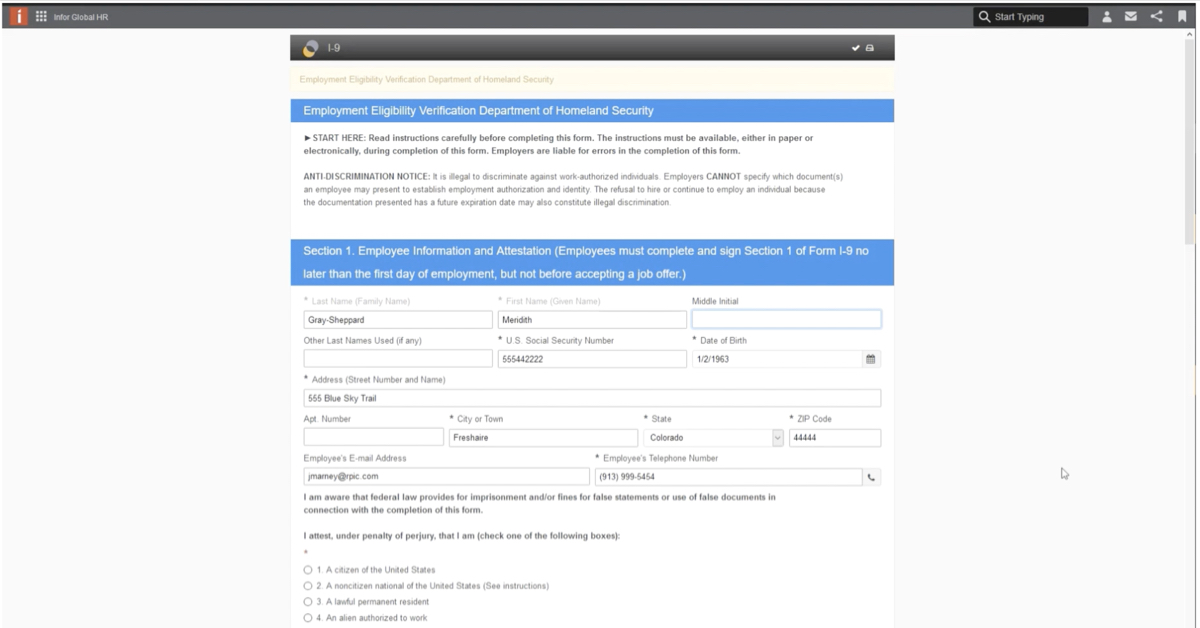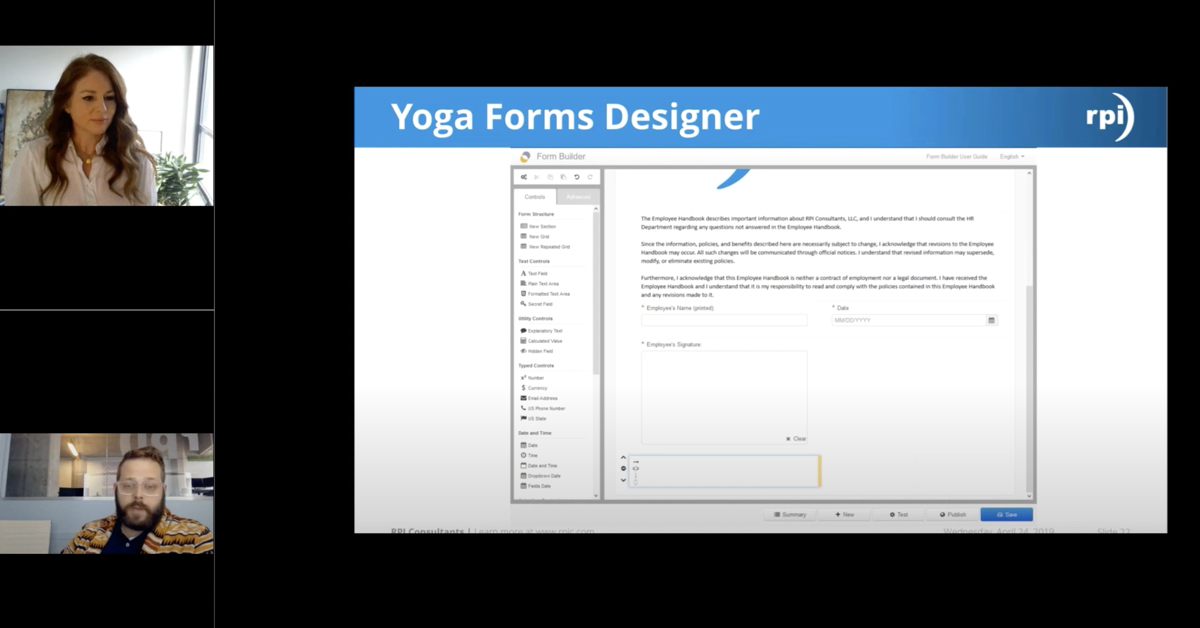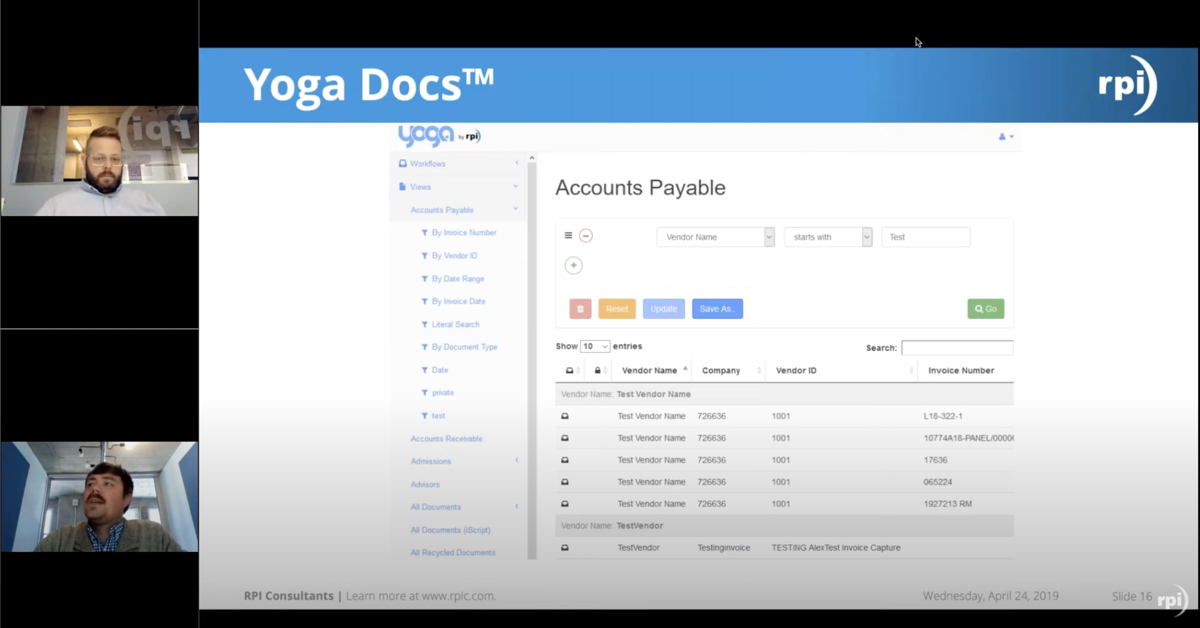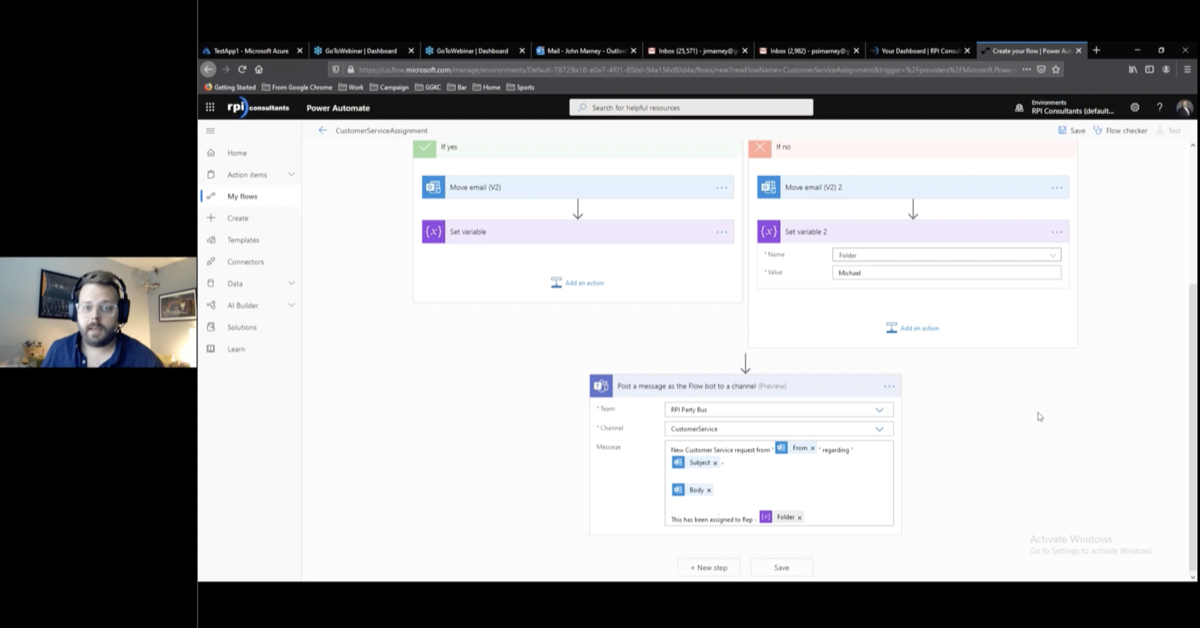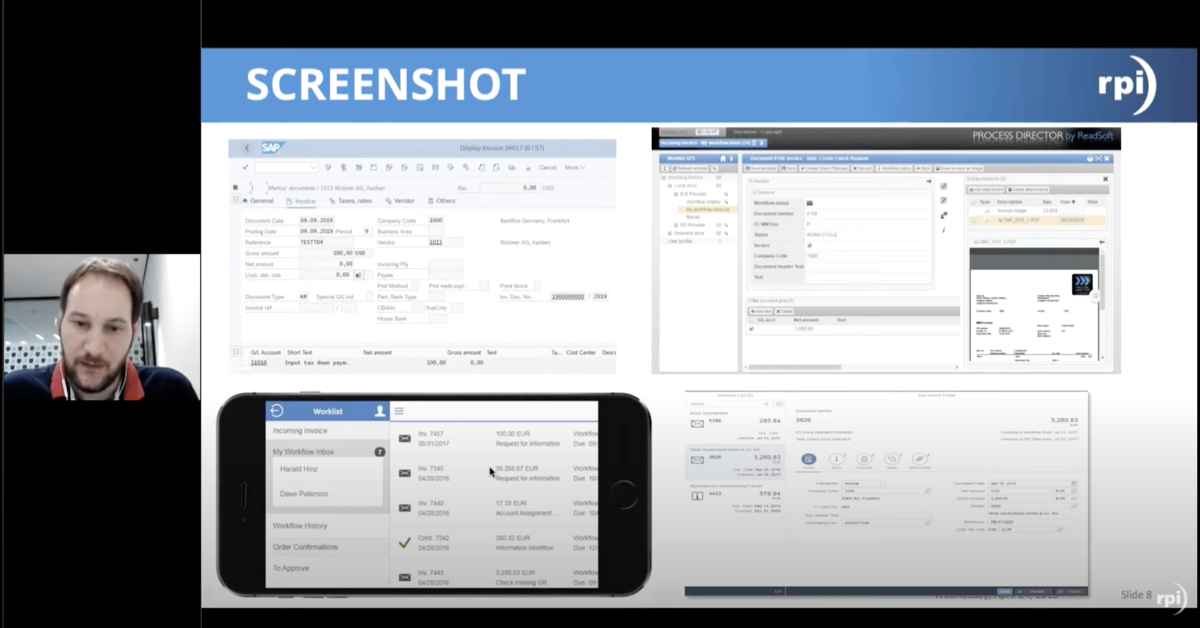Forms Automation for Payroll
Your ERP manages a lot of the heavy lifting in Payroll but the processes surrounding payroll still rely heavily on manual data entry and transcription from physical forms. Introducing technology like Forms management and Robotic Process Automation can significantly reduce errors and processing times by forcing data to be validated before it’s submitted by end users and integrated data directly into your ERP.
Transcript
John Marney:
Thanks for joining us everyone. Welcome back, if you joined us for our 11 o’clock presentation on IBM and CloudSuite, my name is John Marney. Thank you, Keith, for the wonderful introduction. Today we’re going to be talking about forms automation solutions for payroll. The automation solutions that we’re talking about leverage a number of different software technologies. However, most of the concepts that we’re talking about apply broadly to various workflow, form platforms, etc. This is one part of a larger webinar week that we’re hosting here in Kansas City, that is running all week. Please visit our website if you are interested in any of the enforced focus or any of the other enforced focus content. January webinars, we will return to a regular form once a month for the CPA practice and the content for January TBB. We’re looking at doing some fresh on base presentations. We do have some upcoming office hours where we do a little bit more of a technical deep dive into some specific topics and products.
In December, we’re going to be talking about image snap tasks. And in January, we’re doing our rescheduled November office hours for our Perceptive experience. If you don’t know me, again, my name is John Marney. I’m the manager of Solution Delivery here at the content and process automation practice at RPI, we focus on various content and workflow platforms such as Perceptive, OnBase, Kofax TotalAgility, what have you, as well as our own suite of Yoga products for various automation. I’ve been doing this for nine plus years, scary, close to 10. It’s been, it’s flown by. I am a connoisseur of fine product documentation. I know a good one when I see it and I am a proud father of a, almost nine-month-old. Also, the height and weight of a two-year-old.
Mason Auch:
Alrighty, well my name is Mason Auch. I’m a Business Analyst here with RPI Consultants. I have two years of automation experience. I definitely have some wanderlust. I love going out, or a wunderkind, going out and kind of experiencing different things and just the memories that that creates. I’ve raced a Formula One style open road race car on Michigan’s International Speedway and I’m a whiskey connoisseur.
John Marney:
Wow, speed demon. Okay, so agenda today we’re going to walk through some of the payroll workflows and processes that can leverage automation. Then we’re going to kind of switch gears and talk about some of the technology products that can be used to introduce automation into your workflows. And then we’ll kind of combine the two and talk about how those technologies are applied to solve the automation challenges within those workflows. We do have about an eight to ten-minute demonstration from our Senior Solution Architect, Alex Lindsey.
Finally, we’ll take questions. Again, if you don’t know how to take questions, please expand the go to webinar panel. There’s a questions [inaudible 00:03:49] type it in and we’ll get to it, whether it’s during the webinar or at the end. Okay, so let’s talk about payroll workflows of processes that we want to automate for you. First one is a payroll check request. So similar to any other types of check requests within your organization. These are for a manually cutting a check outside of your typical payroll processes. Most often, in most organizations, this is going to be a paper form. If you’re lucky, it’s an electronic PDF form that’s distributed out to people available to download and probably still print it out and manually fill it in. And then after it’s submitted, it is generally hand keyed, manually updated in your ERP. The GL data elements, which are generally critical to make sure that the accounting is appropriate for this check request, may be known by the person filling it out.
They may not be known by the person filling it out there and not being really known by anybody. And even if they do fill it out, it may not be valid. So, this, by converting this to electronic form, we can introduce a lot of validations there.
Mason Auch:
Yeah, one of the other big important portions of bringing it into an electronic form is going to be time. If we miss these forms, even by a day, we can miss that pay period, which then depending on your company structure, could be two weeks, could be halfway through the month or even a monthly, a quarterly, depending on how these structures are set up. So, making sure that we keep this form timely is really important. Another important thing that we can do as approvals as well. We can either send these out as emails or we can do entire workflow structures based off these approvals and get them out to the correct people and make sure that this form is filled out correctly as well.
John Marney:
In today’s world, if we’re shuffling around a lot of paper and something that goes through multiple levels of approval, it could get lost or at least not tracked. Another scenario for payroll corrections, so, similar to a check request in that it is a manual outside of the typical payroll processes. However, this could not necessarily result in a check cut by [inaudible 00:05:56] deduction. Again, very frequently a paper form distributed by various means. Maybe just, “Hey, I’m going to email my manager and see if they have a form.” These vary by industry and roles, so there could be a bunch of different versions of this form. There could be a lot of different data that needs to be filled out depending on whether it’s a salary employee, hourly, whether it’s a 1099 or an FTE. And so, so you know, leveraging it. So, you may actually be maintaining multiple different versions of this paper form.
Mason Auch:
Yeah, and there’s various different reasons we want to be using these payroll correction forms. It can be anything from PTL, over to bereavement, or even breaks, or anything along those lines. And we want to make sure that these payroll corrections get submitted timely and quickly as well. So, some of the issues that we see with these paper forms is that a lot of them require reworks or an extended communication. You know, the employee fills out what they think is supposed to be going into these fields. They submit it and when an AP or whatever departments finally get them, they go, “Oh my gosh, this was not even filled out even close to what it’s supposed to.” So now these guys are having to email back and have constant communication with these employees and that just adds time, and it adds just a lot of work on everyone’s behalf.
John Marney:
And every hand it’s another potential for something to get lost or, or not tracked.
Mason Auch:
Right, most definitely.
John Marney:
So, these are two, some two fairly specific examples. There are a ton of examples within payroll or within HR in general, but as far as the employee self-services as a huge area in which various unique forms can be leveraged.
Mason Auch:
Yes, most definitely. And these can, you know, these are very wide array of different options here, anything from your name and address changes, down the life status changes, PTO requests, tax withholding’s, and even expense processing as well.
John Marney:
And the employee onboarding is its own giant area where you could be managing a hundred different types of documents or form variations and struggling not only to get the data captured from the users and submitted an entity ERP in a timely manner, but also struggling with version controlling the different types of forms that you have and more.
Mason Auch:
There is plenty. We can also include our payroll checklists, our timesheets, payroll check runs, and even the paycheck runs as well.
John Marney:
Mm-hmm (affirmative). So, we’re going to jump over to the tech stack that we’re talking about and when we’re trying to deploy automation [inaudible 00:08:35] in this payroll scenarios that were talking about or in other solutions. So, the first one is leveraging Yoga Forms, which is RPIs own rapid deployment form builder.
Mason Auch:
Yes, what’s really nice about Yoga forms, it has a really intuitive form builder. So, it really allows any of our users to be able to build their own Forms and then deploy those across the entire organization once they’re deployed out to that organization. And we can post them either internally or externally. And you know that can cover anything from human resources to AP payroll, and then health organizations with even patient forms as well.
John Marney:
So, there’s lots of form builders out there. Some unique things about Yoga Forms are pre-built integrations with Perceptive, with OnBase, even with Infor. We also have like it lists on here, unlimited usage. We have a single license [inaudible 00:09:28] with unlimited form submissions, meaning other form builders like this will charge per document. Another sort of the next level or even, I wouldn’t even necessarily call it a tier up or down, but at different type of form solution.
Mason Auch:
Yeah, and this is going to be all electronic forms. What we also call our e-forms, right? So, these are very modifiable within ECS, which is our electronic content management systems. We can deploy these to various different groups. So, this is where we can have the outward facing URLs or that inward access into the client or the URL and these are going to be integrated right into those ECM workflows. So, we can leverage reviews, approvals, and then be able to get additional information as well.
John Marney:
The main difference between the two different form solutions are the rapid deployment are typically submitted into whatever workflow system as a document. These E forms, electronic forms, continue to live as modifiable data, as a form throughout whatever workflow system we’re using. Either way we go, we can implement strategies to publish different versions of forms internally or external to organization.
So along with the form solutions, we need to connect the dots. How do we get the forms and the data through the workflow and into the business system?
Mason Auch:
Yeah, and that’s where robotic process automation comes in into play or RPA. So, RPA can do all sorts of different things. It can do automatic extractions and that can be anything from our websites over to ECMs. We can include ERPs and databases with that as well. And what is so unique about RPM is that it’s so dynamic, right? We can use any type of use cases and it can just really fill into anything that we were really needing, and it can save a ton of time for these manual processes that would normally take a decent amount of time.
John Marney:
So, for example, I submit a form, it gets approved maybe through our traditional workflow system. However, I also want to, when it’s uploaded into our business system, I want to post out to the company site or chat program like Skype or send an email out to we’re all responsible or affected parties that has been processed and is ready for payment. Then again when it’s paid and then again when it’s actually been claimed, RPA is a perfect tool to do with those kinds of things. And we walked through a couple of more use cases for RPA.
So, moving on. Now how do we actually apply some of these cases we’ve discussed in the first section with the technology that we discussed in the second section? So, first, payroll check requests. We’re presenting these sort of as a good, a better, a good and better solutions. So have a good solution is we at least get to a place where we can capture that header data on electronic form and by header, we typically mean things like employee details, amounts, accounts, basically everything. But the detail, which is going to be things like your general ledger. It would send a notification to payroll; it would facilitate email approval and then still potentially require manual entry into the payroll system if we didn’t want to build that integration. So, what’s our enhanced solution?
Mason Auch:
So, our enhanced solution here is going to be a little bit more in depth with that GL data. So, we can put rules or restrictions on that to limit our selections for our users or we can also leverage automatic coding and some situations based off the different types of form or different fields that we’ve chosen. With that we can also do some workflow approvals, so instead of just having to utilize email, they can go in and they can approve these through our portal.
What this really allows us is amazing visibility into where each of these, where it is in each of these approval steps. And then finally, we can also just go ahead and automate that posting to the payroll system. Just removing one more point of contact, which is going to take time and it’s going to take our resources.
John Marney:
And within that electronic workforce solution, there’s so many options to help assist your approvals. There are automatic escalations. There are reminders, there are proxy settings for approvers, there are a lot of ways to help drive, not only give you a line of sight, but to drive that approval to actually take place.
Similarly, payroll corrections offer a very in kind a good and enhanced option. So, on the good level, this is still, they’re still valued implementing this type of solution. We are trying to get at least our electronic form that submits to a system. It would provide a least a way to capture the basic description of what correction is needed. Again, sending notifications to, whether email or chat, to whatever employees are affected, can again facilitate email approval. Even if not giving you the benefit of the visibility and a workflow approval can still help keep that digital record moving. And, and finally, again, if the integration wasn’t already ready, we would still offer manual entry from the digital form to the system.
Mason Auch:
Yeah, and our enhanced version of that. So, one of the big things that we get from this is going to be kind of restrictions that we can do on certain fields based off of what they’ve chosen before. So, we can make sure that we do a little bit more data governance there and validation. With that as well, we can also do direct integration into our workflows, which then going back to kind of our previous conversation, those workflows that we can build off anything that we’re needing to. We can do dynamic email notifications with those reminders. And then finally we bring in that ERP integration as well. And there’s a few different ways of doing that. We can do that using API, database inserts, or even a flat file drop.
John Marney:
Absolutely. So, what’s the good solution for employee self-service?
Mason Auch:
Yeah, so for employee self-service it’s going to be primarily paper forms. For those submissions, the documents are then going to be scanned or archived in an employee file. And then finally, the electronic forms from manual updating. So that yourself can go in and you have to update those benefits, taxes, and then the employee status as well.
John Marney:
So, in our enhanced solution for employee self-service, we want to fill in any gaps that the business system isn’t providing. So, whether that’s a fully integrated form supportive for all needs, whether it’s just some forms that are not available within the business application. No matter what it is, all of these are web based, able to present to or easily accessible by the employee. Maybe it’s a check request or a timecard correction by a manager or a referral or some kind of spiff for a commission. All options and different types of forms that can be provided. And it is completely integrated in with the, the portal is completely integrated or even layered on top of the business application so that data immediately transfers in.
So some more options to leverage automation with the tools, we have a ton of different ways RPA can be leveraged.
Mason Auch:
Yes, most definitely. We can utilize RPA on any type of time sheet audit or approvals. We can do that for expense processing, background checks, and even paycheck runs. And like you kind of talked about, these are just some very high overviews of what RPA can do. It can really do a lot if we want to be able to leverage it.
John Marney:
Right, we have a number of other webinars and materials, like White Papers available on RPA. If you are interested in finding out more. [inaudible 00:17:25] about the background checks. One of the great or the great benefits of RPA is its ability to interface with virtually any system that’s available from your computer. So, working with third parties who may not have an API or something to be integrated with, is exactly where RPA can shine. So, we’re going to move into a video demonstration. Again, this is about eight to 10 minutes. You’re going miss our beautiful faces and you’re going to get to hear Alex talk for just a few minutes.
Alex Lindsey:
Hello, my name is Alex Lindsey with RPI Consultants and today we’re going to do a brief overview of different form technologies that you can use for your systems and how those can be applied to a payroll department and other items that you may choose to use within your payroll department or any other department or really just an overview of form technologies that we like to work with. First and foremost, I’m going to show you a little bit of a payroll corrections form here, and this is within Yoga Forms itself. That’s a software that allows you to build your own form. It’s very intuitive for end users. So, if you’d like to deploy let’s say one or two forms as a project with us, then you can kind of take it and run with it from there. That’s perfectly fine.
So, the first one that we’re going to look at here is a payroll corrections form. So, if an employee has to make an adjustment to a payroll period or future payroll period, or the timekeeper manager needs to make any adjustments, they can do that here. So, within the form you can do all kinds of searches. Again, I’m just going to do a search just based on like my name for instance. And you can get a list of employees here that you’d like to do. And you’ll notice here that it populates this information automatically in the form once you select it. What’s going on in the back end is essentially just a SQL stream. We are calling a database directly to say, “Please return a list of employees where Alex is the first name or contains the word Alex” for instance. It’ll automatically populate that.
Then Yoga Forms, too, you can also do a lot of drop downs for this payroll correction form. Specifically, you can do a general ledger correction, a manual check, or an adjustment. Go ahead and choose adjustment. If you’d like to put in additional documentation, you can do that here as well. Again, I’ll just put it in a text document and that can automatically be loaded and pass through to whichever workflow system you’re working with. For this, I’m just going to say, “Hey, this was the incorrect account charged,” so if you want to put in comments in the pay period for instance that you’re looking to adjust by you can automatically set the correct pay period here.
Yoga Forms also has the option for check boxes or radio buttons like this here. For this one we’re checking to see if this is a grant funded employee or not and we’ve got directions here as well. For instance, if you need to direct this with payroll, for instance, timing is always of the essence, so you want to make sure that any kind of corrections or check requests are done by a certain day of the week by a certain time because you obviously have processes that you need to run internally as part of this as well.
For this, you can do a charge cost center. This is the one that was charged. Here’s the correct one that I need it to be charged to. A timekeeper, which you can choose here, and you can also basically have employees’ managers populated here in the form as well. And again, a lot of this be automated. These can be done from SQL lookups to specific views and things like that. And then once you’re done, you would essentially hit validate and submit and then from there a number of different things can happen. It can go into a specific workflow. It can go into like a Perceptive Content for instance, or a Hyland, OnBase, or even KTA if you would like to do some other additional more dynamic functionality and routing if you want. Essentially what it’s going to do is it’s going to spit out a PDF copy of the document and the metadata as well, so you can use this information and index the document within whatever workflow system or repository that you need to store this document into.
Now the other form I’m going to show you, this has to do with the Perceptive Content Forms, so this is a form server form. This is a payroll check request form. With this, basically the biggest difference between these two form technologies is, is when you submit this form from Yoga Forms that’s going to create a page. It’s going to create a PDF document with this form in the system itself as a representation. However, with Perceptive content forms and forms server, it’ll actually create a form as a document type, and this is something that’s modifiable and that’s really the biggest difference is with Yoga Forms. It’s not necessarily modifiable once it gets into a workflow system because it’s a page and associated metadata. Whereas Perceptive Forms, similar to OnBase as well, this would essentially create a form that allows you to modify within a workflow if you need to make additional changes. If we walked through this one here, you can see it’s kind of the same thing. We’ve got different types of check requests for this. I’m just going to just say referral incentive.
Pull up ID again, just another lookup. That will automatically populate here. I’m going to go ahead and fill in the amount requested $100 it’d be nice. Add to paycheck, yes. Comments like, “This is for a bonus”. And something to call out here too. We can add a lot of validation to these forums, so if it is a referral incentive, you can actually call out a field here for instance, that says, “okay, who’s actually, who’s the referral for?”. Is this an active employee in the system that they’re getting this referral bonus for? Basically, add some validations, some checks that you can put in the form itself. That kind of take away some of the responsibility from the end users and they don’t have to go in and check different things like that. For instance, if it’s employee that doesn’t work here anymore, you can automatically populate the term date.
They’re no longer with the company itself. We’ll go ahead and choose a date here. Along with check requests, there’s typically a lot of GL data that goes into this and this is again a SQL query that we’re directly hitting against a database to pull some of this information. Again, I’m just going to kind of walk through. One thing to call it here with Perceptive Forms as well and Inform Server Forms, we can add additional validation, so if it is a referral incentive, we can do dynamic looks up and auto-populate what this GL information is going to be. For instance, if it’s an employee that’s in a specific department and need to code to that specific department and the account number is always static or the activity code or category is always a static, then you can automatically set these values within the Perceptive Forms. With this one. We’re not necessarily doing that cause we want to enable the users to kind of pick and choose. But if you have that logic already set, then we can automatically set these GL accounts based on different fields, like type on the form itself.
If you want to select a specific pay period, like all right, let’s have this go out on this Friday to be paid. Process level was automatically chosen based on the account number itself. So again, you can default different values based on other values you choose on the form and if it needs to go through approval, you can basically do a search to search which approver it needs to go to. Again, this can also be done automatically. Approvals can be done downstream, where based on, you know, maybe accounting or account number or department that the employees in. You can automatically go to some of these people, or in this instance we can kind of let the user choose which approver that we want it to go to. You can also set up dynamic rules, so if it’s over $1,000 or greater, it could actually go to a VP where you can sort by job code or title or something like that and have the user select specifically which one it is and again, this can be done automatically as well.
If you need to add attachments, you can do that here as well. Choose this and that will pass along with the document itself. Because this is a Perceptive product, this integrates directly into Perceptive Content automatically. There’s some backend configuration that goes on to say, “Hey, where do I want this document to go after the facts?” In this instance, it’s going to come over to Perceptive content. You can see here we’ve basically got this; it’s been here for 11 seconds now. If you open this, I’m going to open up a preview because a process is running now, you can see the form that we basically filled out. And if you look down here and the thumbnails, you can see here that the form is the first page of the document. Whereas the attachment was the second page of the document, you kind of click through that if you need to see this information.
And again this can go directly into a workflow. You can see here that we’ve indexed the document with some metadata that’s specific to this employee that makes this document easy to find if you need to find it a downstream or after the fact after it’s been processed. So I hope this was informative for you guys, but that is just a very quick run through of the different type of form technologies. Again, Yoga Forms being different than Perceptive Forms. In that Perceptive Forms, you can modify the form downstream and workflow. With Yoga Forms, it’s a highly modifiable form platform that you can use to build additional forms to use across your entire enterprise. Thank you very much.
John Marney:
So, continuing on. That pretty much wraps up our presentation. Again, if you have any questions, please submit them being the Go To Webinar screen. We’re happy to take those now. While we review any questions, thanks for joining us. Again, this has been a presentation on our payroll automation solutions. We do have some upcoming webinars next month and onwards. And for some additional resources, please feel free to visit our website, rpic.com/webinars for more of what we’re doing this week. We have our knowledge base there, and then information on Yoga Forms. All right, so it sounds like that’s it. Thank you for joining us today and come back next time.
Mason Auch:
Have a good one.
Want More Content?
Sign up and get access to all our new Knowledge Base content, including new and upcoming Webinars, Virtual User Groups, Product Demos, White Papers, & Case Studies.
Entire Knowledge Base
All Products, Solutions, & Professional Services
Contact Us to Get Started
Don’t Just Take Our Word for it!
See What Our Clients Have to Say

Denver Health
“RPI brought in senior people that our folks related to and were able to work with easily. Their folks have been approachable, they listen to us, and they have been responsive to our questions – and when we see things we want to do a little differently, they have listened and figured out how to make it happen. “
Keith Thompson
Director of ERP Applications

Atlanta Public Schools
“Prior to RPI, we were really struggling with our HR technology. They brought in expertise to provide solutions to business problems, thought leadership for our long term strategic planning, and they help us make sure we are implementing new initiatives in an order that doesn’t create problems in the future. RPI has been a God-send. “
Skye Duckett
Chief Human Resources Officer

Nuvance Health
“We knew our Accounts Payable processes were unsustainable for our planned growth and RPI Consultants offered a blueprint for automating our most time-intensive workflow – invoice processing.”
Miles McIvor
Accounting Systems Manager

San Diego State University
“Our favorite outcome of the solution is the automation, which enables us to provide better service to our customers. Also, our consultant, Michael Madsen, was knowledgeable, easy to work with, patient, dependable and flexible with his schedule.”
Catherine Love
Associate Human Resources Director

Bon Secours Health System
“RPI has more than just knowledge, their consultants are personable leaders who will drive more efficient solutions. They challenged us to think outside the box and to believe that we could design a best-practice solution with minimal ongoing costs.”
Joel Stafford
Director of Accounts Payable

Lippert Components
“We understood we required a robust, customized solution. RPI not only had the product expertise, they listened to our needs to make sure the project was a success.”
Chris Tozier
Director of Information Technology

Bassett Medical Center
“Overall the project went really well, I’m very pleased with the outcome. I don’t think having any other consulting team on the project would have been able to provide us as much knowledge as RPI has been able to. “
Sue Pokorny
Manager of HRIS & Compensation
MD National Capital Park & Planning Commission
“Working with Anne Bwogi [RPI Project Manager] is fun. She keeps us grounded and makes sure we are thoroughly engaged. We have a name for her – the Annetrack. The Annetrack is on schedule so you better get on board.”
Derek Morgan
ERP Business Analyst
Aspirus
“Our relationship with RPI is great, they are like an extension of the Aspirus team. When we have a question, we reach out to them and get answers right away. If we have a big project, we bounce it off them immediately to get their ideas and ask for their expertise.”
Jen Underwood
Director of Supply Chain Informatics and Systems
Our People are the Difference
And Our Culture is Our Greatest Asset
A lot of people say it, we really mean it. We recruit good people. People who are great at what they do and fun to work with. We look for diverse strengths and abilities, a passion for excellent client service, and an entrepreneurial drive to get the job done.
We also practice what we preach and use the industry’s leading software to help manage our projects, engage with our client project teams, and enable our team to stay connected and collaborate. This open, team-based approach gives each customer and project the cumulative value of our entire team’s knowledge and experience.
The RPI Consultants Blog
News, Announcements, Celebrations, & Upcoming Events
News & Announcements
Prepare for the Cloud with ERP Change Management
Chris Arey2024-04-17T12:49:59+00:00April 16th, 2024|Blog|
Pay Transparency Laws by State & How to Comply
Chris Arey2024-04-05T17:49:03+00:00April 2nd, 2024|Blog|
Live on CloudSuite: Navigating the Post Go-Live Phase
Chris Arey2024-03-23T10:24:11+00:00March 19th, 2024|Blog|
Ready For it? The Infor OS Portal Rolls Out Next Month
Chris Arey2024-03-06T17:22:01+00:00March 5th, 2024|Blog|
Infor CloudSuite Pricing: Navigating the Costs of an Implementation
Chris Arey2024-02-21T17:36:57+00:00February 20th, 2024|Blog|
High Fives & Go Lives
AP Health Check at Jeffries Creates Path for Increased Efficiency, Visibility
Michael Hopkins2024-02-26T13:51:02+00:00November 30th, 2020|Blog, Brainware, High Fives & Go-Lives, Perceptive Content / ImageNow|
Customer Voices: Derek Morgan, MNCPPC
RPI Consultants2020-12-16T17:50:32+00:00August 14th, 2020|Blog, High Fives & Go-Lives, Infor CloudSuite & Lawson|
Voice of the Community: Jen Underwood, Aspirus
RPI Consultants2024-02-26T06:04:23+00:00March 14th, 2020|Blog, High Fives & Go-Lives, Infor CloudSuite & Lawson|
Voice of the Community: Keith, Denver Health
RPI Consultants2024-02-26T06:01:19+00:00March 14th, 2020|Blog, High Fives & Go-Lives, Infor CloudSuite & Lawson|
AP Automation Case Study at Nuvance Health
Michael Hopkins2024-02-26T13:48:07+00:00March 4th, 2020|Blog, High Fives & Go-Lives, Infor CloudSuite & Lawson, Knowledge Base, Kofax Intelligent Automation, Other Products & Solutions, Perceptive Content / ImageNow|
Upcoming Events
RPI Client Reception at CommunityLIVE 2019
RPI Consultants2024-02-26T06:09:32+00:00June 20th, 2019|Blog, Virtual Events, User Groups, & Conferences|
Free Two-Day Kofax RPA Workshop (Limited Availability)
RPI Consultants2024-02-26T13:24:38+00:00June 13th, 2019|Blog, Virtual Events, User Groups, & Conferences|
POSTPONED: Power Your Logistics Processes with a Digital Workforce with Kofax
RPI Consultants2024-02-26T13:29:29+00:00May 29th, 2019|Blog, Virtual Events, User Groups, & Conferences|
You’re Invited: Customer Appreciation Happy Hour
RPI Consultants2024-02-26T06:27:45+00:00March 14th, 2019|Blog, Virtual Events, User Groups, & Conferences|
RPI Consultants Sponsors 2019 Michigan Manufacturing Operations Conference
RPI Consultants2024-02-26T13:53:21+00:00January 30th, 2019|Blog, Virtual Events, User Groups, & Conferences|

